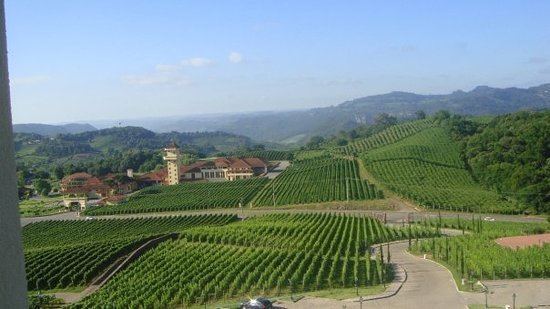Elevation 690 m (2,260 ft) Area 382.5 km² Local time Friday 9:04 AM | Region South Founded 11 October 1890 Time zone BRT (UTC-3) Population 96,830 (2010) | |
 | ||
Weather 26°C, Wind N at 10 km/h, 73% Humidity University Federal Institute of Rio Grande do Sul | ||
Copa rs bento gon alves snakes x s o leopldo mustangs
Bento Gonçalves ([ˈbẽtu ɡõˈsawvis]) is a municipality located in the state of Rio Grande do Sul, Brazil. Created in 1875, it is one of the centers of the Italian immigration in Brazil. It is also known as the 'wine capital of Brazil' due to its vineyards and wine production. In 2013, its estimated population was 111,384 inhabitants.
Contents
- Copa rs bento gon alves snakes x s o leopldo mustangs
- Map of Bento GonC3A7alves RS Brazil
- History
- Economy
- Geography
- Tourism
- References
Map of Bento Gon%C3%A7alves - RS, Brazil
Ernesto Geisel, President of Brazil from 1974-1979 (under the military dictatorship), was born in Bento Gonçalves in 1907.
History
Before 1870, the area where the city is located was known as Cruzinha. It was inhabited, as the rest of the region, by Indians of the "jê" tribe.
In 1875, the Brazilian government created, in the state of Rio Grande do Sul, four settlements to receive Italian immigrants. In the Cruzinha area, a settlement was created called Dona Isabel (named after the Brazilian princess Isabel de Bragança). "Dona Isabel" received the first 25 families of Italian settlers in that same year. They mostly came from the region of Trento.
During the next few decades, the region was settled by immigrants coming mostly from the Italian regions of Veneto, Trentino, and Lombardia.
In 1890, Dona Isabel was elevated to the category of city, changing its name to Bento Gonçalves (named after the military leader of the Ragamuffin War).
The Italian immigrants mostly worked in grape and wine production.
During the first few decades of the 20th century, the city continued to receive immigrants. Besides the Italians, there were large groups of Polish, German, Swedish, French, and Spanish immigrants.
At that time, there were already some functioning wine factories and the furniture and metallurgic industry was just starting to take off.
The railways arrived at the city in 1919, helping to connect it with the capital of the state, Porto Alegre, and facilitating the transport of the city's economic production. There were regular passenger trains running until 1976; however, today the railways are used mostly to transport goods. There is also a tourism railroad line that connects the city with Garibaldi and Carlos Barbosa using an old steam locomotive.
The electric light distribution system was installed between 1919 and 1927. The Bartolomeu Tacchini Hospital was built during the same period.
In 1950, the population was 22,600. Industrial activity expanded, especially in the wine, furniture, leather, chemical, metal, and mechanical sectors.
In 1967, the city organized the first National Wine Festival (Fenavinho), receiving, for the first time, a visit from a Brazilian President.
The city started to organize and receive many important national and international events. It is now home to the second largest exposition park in Latin America. Among these events are the Movelsul (Furniture Fair), FIMMA Brasil (Furniture Machinery Fair), Vino Brasil (Wine Machinery Fair), Avaliação Nacional de Vinhos (National Wine Assessment), Fenavinho e Expobento (Commercial Fair).
Economy
Bento Gonçalves is among the ten largest economies in Rio Grande do Sul. It is the largest producer of wine in Brazil and has the second largest furniture production industry in the country. It also has important metal, mechanical, plastic, and chemical industries. It has the highest Human Development Index of Rio Grande do Sul and the sixth among all Brazilian cities - 0,870 (PNUD/2000).
Geography
The average elevation of Bento Gonçalves is 690 meters above the sea level. The summers are hot and winters are cold with the occurrence of frosts and even sometimes snow falls, but in a small quantity. The record highest temperature in the city was 36 °C and the lowest was -4,5 °C.
Tourism
Tourists can experience the rolling countryside of Bento Gonçalves, Garibaldi and Carlos Barbosa by taking a day trip on the Maria Fumaça steam locomotive. Tourists can also learn more about the Italian heritage of the people through such museums as Epopéia Italiana.
